
34 days Philippines Birding tour 11 December - 13 January
Leader: Bram Demeulemeester
Participants: Chris Steeman, James Holmes, Mark Van Beirs, Paul French, Tim Sykes
PART 1: The Visayas - South Negros & Bohol
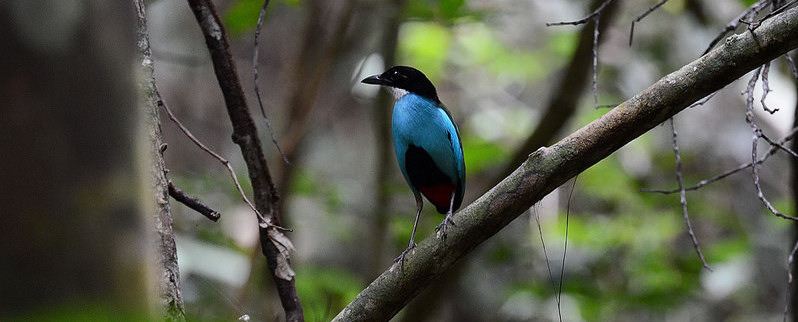
Azure-breasted Pitta
We began our long 34-day tour in the Philippines with an early morning flight bound for Dumaquete in Southern Negros. Upon arrival, we were directly transferred to the scenic Lake Balinsasayao for birding for the rest of the day. We enjoyed several mixed bird flocks holding some of the specialties including: White-vented Whistler, Visayan Fantail, Elegant Tit, Sulphur-billed Nuthatch, Visayan Bulbul, a few Lemon-throated Warblers, and Philippine Tailorbirds. One Flame-templed Babbler showed several times also. Around the lake’s view deck and restaurant, we had stunning views of Maroon-naped Sunbirds and Magnificent Sunbirds. We took a short boat ride around the lake which resulted in some views of Visayan Hornbills.
The next day we set off very early from our hotel in Dumaquete towards Mt.Mantiquil. Along the way we had stunning views of a Philippine Serpent Eagle. We made a short stop in a forested patch along the way to look for the Visayan Shama. One gave very nice views paired with his beautiful song. We made our way towards the higher forested mountains to look for the main target bird: the Negros Striped-Babbler. A two-hour climb took us to the right habitat for this Babbler which gave us several good views. It showed up along with White-winged Cuckoo-Shrikes. We soon made our way downhill with plenty Striated Swallows and Barn Swallows together with Ameline Swiftlets, Pygmy Swiftlets, and some far away Purple Needletails. We observed at least two Asian House Martins, which previously have had only a few records from the same site in the Philippines. We were rather happy with these sightings. Towards the evening, we made our way back to the small town of Valencia to look for the Negros Scops-owl. It gave amazing views after some hours of searching. Spotting the owl was a happy way to end our long day and our short visit to South Negros.
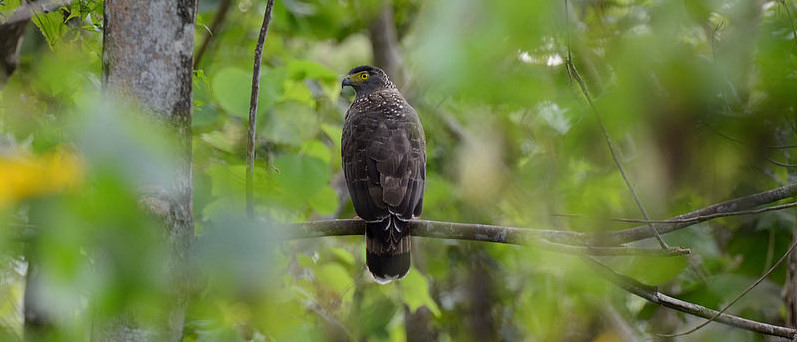
Philippine Serpent Eagle
A short flight from Dumaquete took us to Cebu City. Here, we were transferred to the ferry terminal for a short sea crossing to Bohol. We soon arrived on the island and made our way to the Rajah Sikatuna Natural Park. We just had some time for some nocturnal birding that day. We got nice views of Great-eared Nightjars and also of the Everett’s Scops-Owl and Luzon Hawk-owl (Philippine) while we spotted a stunning Philippine Colugo. We ended the day and got ourselves ready for the next day’s birding inside the park.

Philippine Colugo
A short ride before dawn resulted in a very brief view of an Eastern Grass-owl along the way. We reached the clearing inside the park and we waited for first light, entertained by some Samar Hornbills who showed very early. We soon made our way up the trails where we spotted a Black-faced Coucal and one stunning Azure-breasted Pitta which showed very well, much to our delight. Two amazing-looking Visayan Broadbills also gave prolonged views later that day moving slowly among the trees with Rufous-tailed Jungle Flycatchers in the background. The mixed bird flocks we encountered included: Yellow-bellied Whistler, Mindanao Drongo, Black-crowned Babbler, several Brown Tit-Babblers, Philippine Leaf Warblers, and Black-naped Monarchs. One pair of Striated Wren Babblers showed up several times and Yellow-breasted Tailorbird was seen after some searching. One Philippine Fairy Bluebird was seen briefly but we had several looks at the stunning Northern Silvery Kingfisher that was seen both inside and outside the park.
We had one more morning to spend inside the park, and we were able to observe Amethyst Brown Dove, Philippine Green-Pigeon, Philippine Drongo Cuckoo, and Philippine Trogon. The Rufous-lored Kingfisher and Philippine Oriole remained heard only during our stay. The next day we ended our short stay on Bohol and headed towards Mindanao. We had to say goodbye to Mark and Chris who stayed an extra day on Bohol.
PART 2: Mindanao – Mt. Kitanglad, Camiguin, & PICOP
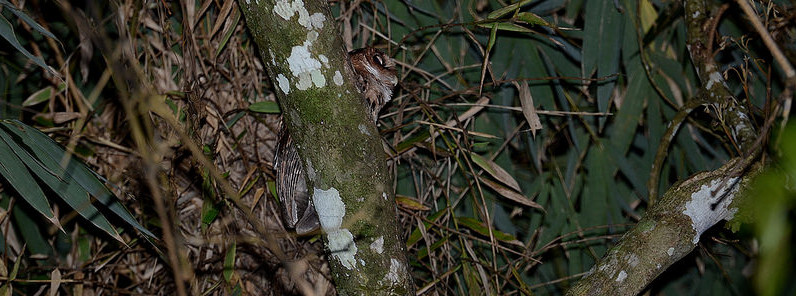
Giant Scops-Owl
We took an early morning flight the next day from Cebu to Cagayan De Oro. From there, we drove towards the base of Mt. Kitanglad. A short hike took us to the Del Monte Lodge where we based ourselves for the next three nights. Our first exploration around the lodge and surrounding forest patches resulted in some of the more common species found on the mountain such as several Philippine Hanging-Parrots, Philippine Coucal, Whiskered Treeswift, Mindanao Hornbill, Buff-spotted Flameback, Elegant Tit, Sulphur-billed Nuthatch, Grey-streaked Flycatcher (a common visitor throughout the Philippines), Little Pied Flycatcher, and Turquoise Flycatcher. Plenty of Eyebrowed Thrushes were also present. The very common Mountain White-eye showed up everywhere we looked, making it the most common bird during our stay. The more uncommon Short-tailed Starling was also seen several times. Olive-capped Flowerpecker and Fire-breasted Flowerpecker where all spotted on the last hours of our first day on the mountain. Towards dusk, we had our first sightings of the Bukidnon Woodcock and Philippine Nightjar. The friendly Philippine Frogmouth showed very well also giving us prolonged views. Several hours later after our dinner we were ready to search for the Giant Scops-owl that showed well after some time searching.
The next morning, we made our way up to the Philippine Eagle viewpoint. Most of our time was spent that day waiting for the Eagle. It showed up after several hours waiting. Initially, we had decent flight views of this mighty Eagle and later on, it landed on a tree across the valley giving us long but distant views through the scope. Pinsker’s Hawk-Eagle and Crested Honey-Buzzard were also seen that morning while waiting for the Philippine Eagle as well as a single Peregrine Falcon. Philippine Cuckoo Dove, Yellow-breasted Fruit Dove and several Mindanao Racquet-tails were seen in flight. Stripe-breasted Rhabdornis, more Philippine Hanging-Parrots, Brush Cuckoo, and Philippine Coucal were also seen that day. While waiting for the Eagle, we also observed several Philippine Swiftlets. On the trail from the Lodge to the Eagle viewpoint and back, we observed several bird flocks adding more species to the list, including the very beautiful Black-and-Cinnamon Fantail, Negros Leaf Warblers, along with some of the more commonly observed species like the wintering Brown Shrikes, Long-tailed Shrikes, Striated and Tawny Grassbirds, Eastern Yellow Wagtails, and Paddyfield Pipits. That night, we got a second chance to spot the Giant Scops-owl again.
We started our morning the following day with some nice views of the Blue-capped Kingfisher that was first heard near the lodge. We spent most of the day in search of the higher montane specialties that can be found on the slopes of Mt.Kitanglad: Mindanao Racquet-tail, McGregor’s Cuckoo-shrike, Black-masked White-eye, Apo Myna, and the Apo Sunbird.
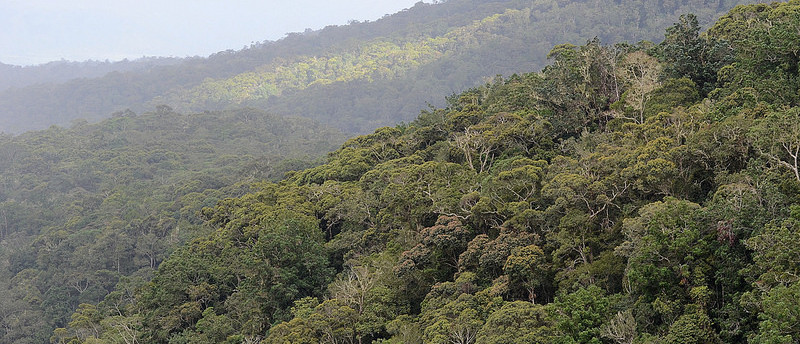
Mt.Kitanglad views
The next morning, we had to leave Mt.Kitanglad early to reach Camiguin Sur Island where we spent the next two days birding. With the recently described species of Hawk-owl in Camiguin, this makes the scenic island a very interesting stop to spot the new species split. We had the chance to see the Camiguin Hawk-owl soon after our arrival on the island. We made our way to the forest at dusk and found ourselves very lucky to have seen two Camiguin Hawk-owls together.
The next two days were mostly spent birding along the road and also in some side trails. Rufous-lored Kingfisher was seen after some time searching and a Red-bellied Pitta gave some rather stunning views. Also seen were Rufous Paradise-Flycatcher, the interesting-looking Black-naped Monarch, and the Yellowish Bulbul with its different song from the mainland of Mindanao which makes it a future potential split. Other species seen were Mangrove Blue-Flycatcher, Philippine Magpie-Robin, Philippine Cuckoo-Dove, Blue Rock Thrush, Everett’s White-eyes, Purple-throated Sunbirds, and White-bellied Munia. We also had some stunning views of the Variable Kingfisher that was seen near a small stream at the back of a resort. While on the island, we had the chance to see the Camiguin Hawk-owl several more times. It was a nice stop for two days after out stay on Mt.Kitanglad. We were soon on our way to P.I.C.O.P. in the eastern lowlands of Mindanao for the next three days.
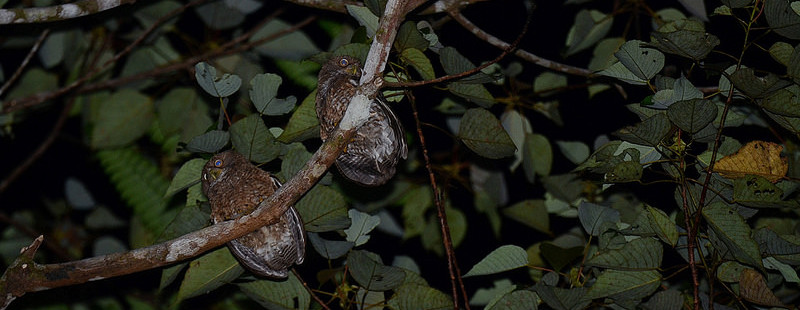
Camiguin Hawk-owl
The first morning in P.I.C.O.P. was spent in the rapidly vanishing eastern lowland. We birded in the lower part of the old logging concession area which was still a very birdy place with plenty good birds seen: Barred Honey-Buzzard, Guaiabero, Blue-crowned Racquet-tail, Philippine Coucal, plenty of Ameline Swiftlets, splendid views of the Southern Silvery Kingfisher, Mindanao Hornbills, Writhed Hornbills, one Philippine Oriole, Mindanao Blue Fantail, Black-naped Monarch, Rufous Paradise Flycatcher, Large-billed Crow, Yellowish Bulbul, Rufous-fronted Tailorbird, and the very rarely seen Little Slaty Flycatcher was seen very well. Small flocks of Brown Tit-Babbler were regularly encountered as well as Olive-backed Flowerpecker and Metallic-winged Sunbird. Later that afternoon, we made a quick stop at the old airfield in Bislig and saw Wandering Whistling-Ducks, Philippine Ducks, Blue-breasted Quail, Yellow Bittern, Easten March-Harrier, White-browed Crake, and Purple Swamphen.
On the second day, we took a two-hour drive to the higher parts of Bislig. We stopped along the road where we encountered a huge flock with Mindanao Blue Fantails, Short-crested Monarch, Philippine Leaf-Warbler, Mindanao Pygmy Babbler, Rusty-crowned Babbler, Everett’s White-eye, and Naked-faced Spiderhunter. Many other species were seen that day including: Stripe-headed Rhabdornis, Philippine Leafbird, Bicoloured Flowerpecker, Metallic-winged Sunbird, Handsome Sunbird, White-bellied Woodpeckers, Rufous Hornbills, Mindanao Hornbills, and Writhed Hornbills. We also saw three Azure-breasted Pittas that day and got prolonged views of the stunning Celestial Monarch. Adding to our very successful day were other goodies like the Black-headed Tailorbird and Philippine Fairy-bluebird.
Another full day was spent in the lowland forest of P.I.C.O.P with several more birds seen including another good look at the Barred Honey-Buzzards, Philippine Serpent-Eagle, White-eared Brown Dove, Philippine Green-Pigeons, Green Imperial-Pigeons, Black-faced Coucal, Philippine Coucal, Bar-bellied Cuckoo-shrike, and Scarlet Minivet which is another possible future split. More species seen include Yellow-bellied Whistler, Mindanao Drongo, Mindanao blue Fantail, Yellow-wattled Bulbuls, and the very common Philippine Bulbuls. We also got good views of the Striated Wren-Babbler. We also saw more Brown Tit-Babblers, Everet’s White-eye, Olive-backed Flowerpecker, Bicoloured and Red-keeled Flowerpecker, and long views of the Handsome Sunbirds. We ended our day at dusk where we spotted the Mindanao Hawk-owl and ended our three days birding at P.I.C.O.P.
PART 3: Palawan – Luzon, Mt. Makiling, Candaba, Subic, Mt. Polis, Camp Sawa

Copper-throated Sunbird
From Bislig, we transferred early morning to Butuan were we took our flight to Puerto Princesa in Palawan via Manila. We arrived later that day, ready to rest for the night for an early start at the Balsahan Trail. We spent the entire morning along the Balsahan Trail in search of our first Palawan endemics. Some of the specialties that showed very soon were the Palawan Flycatcher and Melodious Babbler. We enjoyed the very bird-active trail with Green Imperial-Pigeon, Square-tailed Drongo-Cuckoo, Chestnut-breasted Malkoha, nice views of the Rufous-backed Kingfisher and Ruddy Kingfisher, Spot-throated Flameback, and prolonged views of Hooded Pitta. We also saw Palawan Crows and our first Palawan Tits which are not often seen on the Baslahan Trail. Other birds on the trail were the very common Black-headed Bulbul, Ashy-fronted Bulbul, and Palawan Bulbul. Added to the list were Rufous-tailed Tailorbird, the wintering Grey-streaked Flycacther, White-vented Shama, a few Ashy-headed Babblers, and Pin-striped Tit-Babblers which were probably the most common bird seen. We also enjoyed seeing a large group of Common Hill Mynas feeding on the trees. Also sent that morning were Yellow-throated Leafbird, Palawan Flowerpecker, Purple-throated Sunbird, Lovely Sunbird, and Pale Spiderhunter making for a good start for our Palawan visit. Along the way out we stopped at several rice paddies with White-browed Crake, Common Sandpiper, Common Greenshank, Marsh Sandpiper, plenty of Wood Sandpipers, Red-necked Stints, Long-toed Stints, and Whiskered Terns. We made a stop at the mangroves where we had a look at the very beautiful Copper-throated Sunbirds that we enjoyed for some time. During lunch, we spotted a Stork-billed Kingfisher. Later that afternoon, we made our way to Cowrie Island and saw an over-sea, low-flying Peregrine Falcon and several waders on the mudflats including Greater Sand-Plovers, several Kentish Plovers, plus a Whimbrel which was seen later on. We ended our long first day with splendid views of the Mantanani Scops-owl.
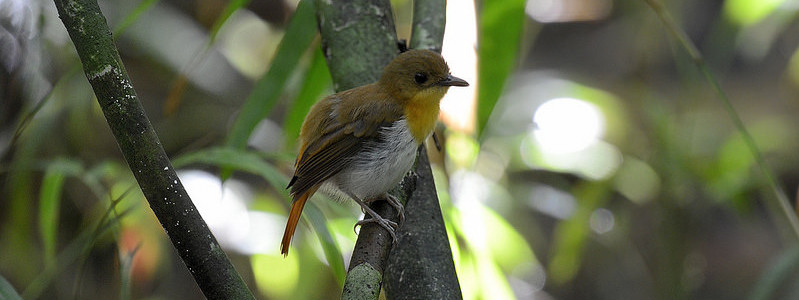
Palawan Flycatcher
Early morning the next day, we made our way to Sabang beach to spend the next two days there. We made several stops along the way and we added several more endemic birds to our list: several Blue-headed Racquet-tails, the extremely beautiful Red-headed Flambeback, Spot-throated Flameback, and the prehistoric-looking Great Slaty Woopeckers. Ashy Drongos and Palawan Drongos were also seen regularly as well as Sulphur-bellied Bulbul, Palawan and Ashy-fronted Bulbul, Asian Fairy-bluebird, and Palawan Blue-Flycatcher. We got lucky with several views of the Falcated Wren-Babbler on a small side trail from the main road. Several more Yellow-throated Leafbirds, Palawan Flowerpeckers, Purple-throated Sunbirds and Lovely Sunbirds were also seen. The afternoon was spent at the viewpoint waiting for the Philippine Cockatoos, some of which gave us some scope views. Our nocturnal search resulted in some splendid views of the elusive Palawan Scops-owl.
Next morning we started very early in search of the Palawan Frogmouth that gave us excellent views at dawn. We headed out for the Headquarters of the Subterranean River National Park to look for the famous Palawan Peacock-Pheasant, which showed up after some time. It is always a great experience to see this fantastic bird. We also saw the Philippine Scrubfowl in the area.
Later on, we were birding along the road again where we saw Crested Goshawk and Besra. Other species seen were Thick-billed Pigeons, Green Imperial-Pigeons, Dollarbird, another Red-headed Flameback which was more than welcome and always a stunner to see. We also saw Great SlatyWoopecker, Yellow-throated Leafbird, Palawan Flowerpeckers, Lovely Sunbirds, and Pale Spiderhunter. We got a surprise of the day when two Spotted Wood-owls showed toward dusk. It was a very nice way to end our day.
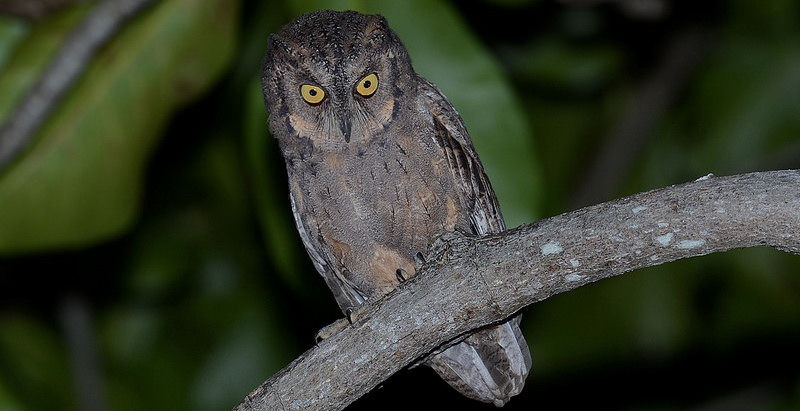
Mantanani Scops-owl
We made our way back to the airport on the afternoon of our last day in Palawan with several more stops birding along the way back to Puerto Princesa. Species seen include: Crested Goshawk, another view of the Blue-headed Racquet-tail, Plaintive Cuckoo, Square-tailed Drongo-Cuckoo, Palawan Hornbill, White-bellied Woodpecker, Spot-throated Flameback, Dark-throated Oriole, Ashy and Palawan Drongos, Palawan Crows, and the Palawan Tit showed up once again. It is always good to see this stunner. Ashy-fronted, Palawan and Sulphur-bellied Bulbuls were all spotted again along with Yellow-throated Leafbirds, Palawan and Orange-bellied Flowerpeckers. Spotting some Purple-throated Sunbird, Olive-backed Sunbirds and Lovely Sunbirds was a nice way to end our successful stay in Palawan. We took our flight to Manila and spent New Year’s night there and got ready to start our Luzon journey.

Lovely Sunbird
On our way to Mt. Makiling, we made a stop at La Mesa Eco Park in Quezon City. This is a good spot to look for Ashy Thrush, which we enjoyed seeing several times along with a Spotted Wood Kingfisher that was easily seen. We also had long very close views of a jewel-like Red-bellied Pitta, Emerald Dove, Philippine Pied Fantail, Grey-backed Tailorbird, Mangrove Blue-Flycatcher, splendid view of a wintering Scaly Thrush, and several Lowland White-eyes. It was a nice way to spend the morning of New Year’s day.
Soon we were on our way to Los Banos at the base of Mt. Makiling for an afternoon birding around the open fields. Species seen include: Buff-Banded Rail, Barred Rail, White-breasted Waterhen, Coppersmith Barbet, Brown Shrike, Oriental Skylark, Eastern and Grey Wagtail. We also got splendid views of our main target birds: the Spotted Buttonquail and Barred Buttonquail, which was a great way to end our first day of the new year.

Scaly Thrush
Next day, we started very early to make our way slowly up to the hot springs on Mt. Makiling. We saw Philippine Cuckoo-Dove, Black-chinned Fruit-Dove, Philippine Hanging-Parrot, the bizarre-looking Rough-crested Malkoha, and Scaly-feathered Malkoha. We saw another Spotted Wood Kingfisher plus Philippine Pygmy Woodpecker, Bar-bellied Cuckoo-shrike, Yellow-bellied Whistler, several Balicassiaos, Black-naped Monarch, Elegant Tit, Sulphur-billed Nuthatch, and Grey-backed Tailorbird. We got stunning views of the usually very shy White-browed Shama. Also seen were one Scaly Thrush, Stripe-headed Rhabdornis, scoping views of the Grey-throated Sunbird, and good views of the Flaming and Handsome Sunbird. The afternoon was spent in the Botanical Garden in search for the Indigo-banded Kingfisher that showed up after some time scanning the stream. While waiting for the Kingfisher, a few wintering Brown-headed Thrushes showed up. Later on we had additional prolonged views of the Indigo-banded Kingfisher that was seen along the stream at the university campus.
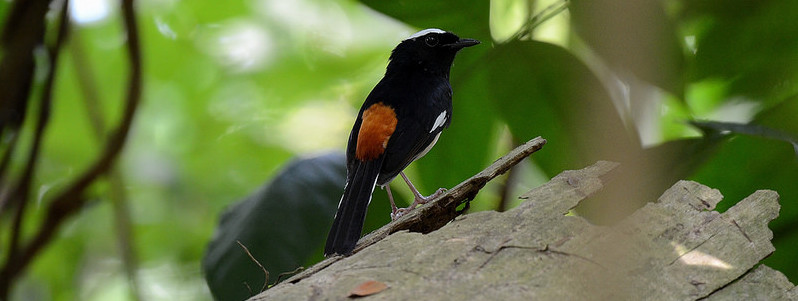
White-browed Shama
We left Mt. Makiling very early the next morning to make a quick stop at Candaba Marsh on our way to our next destination: Subic Bay. We spent several hours at the Marsh which is always an ideal place to give our bird list a good boost. In Candaba we saw Wandering Whistling-Ducks, lots of Philippine Ducks, Yellow Bittern, Black Bittern, Black-crowned Night-Heron, Barred Rail, White-browed Crake, Purple Swamphen (a potential split to Philippine Swamphen), Common Moorhen, Pacific Golden-Plover, Kentish Plover, Little Ringed Plover, Black-winged Stilt, Common and Wood Sandpiper, Long-toed Stint, Whiskered Tern, Red Collared and Spotted Doves, Common Kingfisher, Oriental Skylark, Barn and Pacific Swallow, Artic Warbler, Clamorous Reed-Warbler, Striated Grassbird, ZittingCisticola, Pied Bushchat, and plenty of Chestnut Munias.
We soon left and were on our way to Subic Bay for more birding late in the afternoon and a full next day in this very active bird area. In the trails, we saw Philippine Serpent Eagle, Philippine Green-Pigeon, Green Imperial-Pigeon, and Guaiabero. We also saw some of the real specialties in this site including the Green Racquet-tail, several Blue-naped Parrots, Philippine Hanging-Parrots, Rough-crested Malkoha, and a large group of Rufous Coucals. Also seen were Philippine Coucal, Brown-breasted Kingfisher, and plenty of Rufous crowned Bee-eaters. We had several encounters with the Luzon Hornbill, Philippine Pygmy Woodpecker, White-bellied Woodpecker, Luzon Flameback, Northern Sooty Woodpecker, Bar-bellied Cuckoo-shrike, Blackish Cuckoo-shrike, a flock of wintering Ashy Minivets, Balicassiao, Elegant Tit, Grey-streaked Flycatcher, and many Coletos. At night time, we succeeded with some great views of the Chocolate Hawk-owl. On our last night in Subic, we noticed a distant call from a Philippine Eagle-owl near our accommodation. After some time searching, we spotted our first Philippine Eagle Owl and it was soon joined by a second owl. We really enjoyed seeing them calling in a duet. It was a mega experience to see two of these mighty Owls together. Next morning, we still had the chance to bird for several more hours along the road in Subic before we prepared ourselves for a long drive north to Banaue, the base to explore the Central Cordilleras specifically Mt. Polis, where we would spend the next two full days.
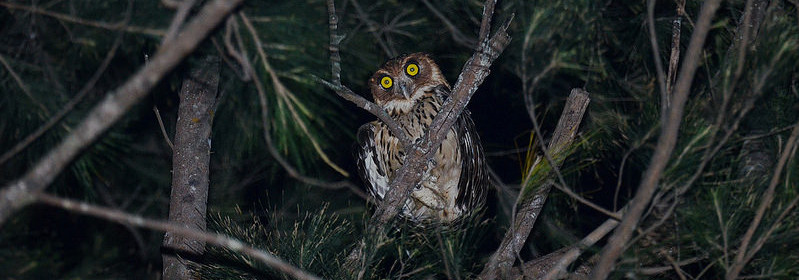
Philippine Eagle-owl
We arrived on our first morning before dawn at Mt.Polis. We immediately heard our first distant calls of the Luzon Scops-owl although we had no luck on our first attempt. In some rather foggy weather, we birded mainly along the road to scan the forest edges hoping for the early flocks to catch the first sunlight. We saw Green-backed Whistler, Blue-headed Fantail, Citrine Canary-Flycatcher, Elegant Tit, Mountain Tailorbird, Sulphur-billed Nuthatch, plenty of Mountain Leaf-Warblers (Negros). With their different looks from the Mindanao and Visayas races, this is a good candidate for a potential split. Also seen were Turquoise Flycatcher, plenty of small flocks of the Chestnut-faced Babbler, and Mountain White-eye. Several of the less common Flame-crowned Flowerpecker were spotted among the bird waves, and one even gave a rather close view. A few Luzon Sunbirds gave splendid views, which are always good birds to see. We also had prolonged views of the Luzon Redstart that was seen along a waterfall just along the road. A single Mountain Shrike was seen and the Philippine Bush-Warbler was often more heard than seen. The Long-tailed Bush-Warbler remained heard only on our first day.
On our second and last day on the mountain, we started birding again well before dawn. This time we had more luck with one of the Luzon Scops-Owls that gave excellent close views. We also enjoyed more mixed bird flocks and also a good view of the Long-tailed Bush-Warbler. Some Flame-crowned Flowerpeckers also joined the bird waves. Around our accommodation in Banaue, we saw several Yellowish White-eyes. The next day, we had to leave the cooler central mountains for our last part of our long birding tour: The Sierra Madre Mountains.

Forest views at Camp Sawa
A long drive took us from Banaue to Tuguegarao. When we arrived, we had a full lunch to stock up on energy for the long walk towards camp one. We were met by our local guide and with his team of porters we made our way and began our trek. We started our hike in the afternoon with few birds along the way until we reached our camp for one night’s stay. A few Philippine Green-Pigeons were seen as well as a Luzon Hornbill. The main attraction was the big flock of at least thirty Spotted Imperial-Pigeons that we were able to observe nicely before we reached our camp.
We left in the morning to hike slowly towards Camp Sawa where we would spend the next three full days. On our way to Camp Sawa, we looked out for some of the specialties: Furtive Flycatcher and White-lored Oriole, both of which were seen nicely. We were very lucky to spot one Sierra Madre Crow that showed very well. Once we reached our main camp, we had our well-deserved lunch before we set off again for our afternoon hike. A very shy Cream-breasted Fruit-Dove was seen. Our main target bird for the site is always the Whiskered Pitta. We were very lucky to see two of these amazing looking Pittas on our first afternoon there. We had prolonged and splendid views of these Pittas, so we were very relieved that we could concentrate the following days on finding more of our target species. We saw Crested Honey-Buzzard, Yellow-breasted Fruit-Dove, Black-chinned Fruit-Dove, Rough-crested and Scaly-feathered Malkoha, Philippine Trogon, and Spotted Wood Kingfisher. We also saw a few distant Rufous Hornbills and many Philippine Fairy-bluebirds. We encountered several flocks which included Blue-headed Fantail, Yellow-bellied Whistler, Citrine Canary-Flycatcher, Sulphur-billed Nuthatch, Lemon-throated Warbler, several Golden-crowned Babblers, and at least three Luzon Striped-Babblers. Blue-breasted Flycatcher was also seen very well. We also had good luck spotting one Sierra Madre Ground Warbler that gave some decent views and one Luzon Bleeding-heart was seen. On the way out, we were able to see the Indigo-banded Kingfisher once again. A long hike took us to our transport that was waiting for us along the road and we rode to Tuguegarao for an overnight stay. The next day, we took the afternoon flight to Manila for a last night before it was time to say goodbye to Tim and Paul after this long and exciting birding tour through the Philippines.
Read also more about this tour on Paul French blog: nomadbirder birding in around Britian and beyond.
See also our previous tour report to Mindanao, Palawan and Luzon
